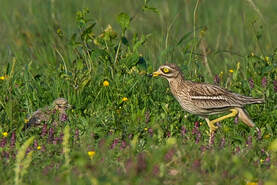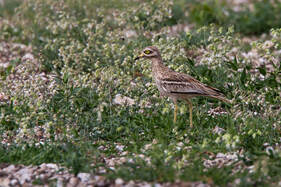 Stone curlew with its chick. Photo: RSPB Ian Grier Stone curlew with its chick. Photo: RSPB Ian Grier The stone curlew is a great conservation success and the species has been brought back from the brink. If you missed the talk or if you'd like to listen again, you can do so here but otherwise here is a brief summary. If there's an endangered bird, be it cirl bunting, osprey, sea eagle or stone curlew, Nick Tomalin is most likely to be leading the team working to help populations recover. The Wessex Stone Curlew project has been running since 1985 and has seen the population increase from just 30 pairs to over 100 – one-third of the whole UK population of around 350 breeding pairs – and has the support of around 300 farmers. Back in 1768, Gilbert White of Natural History of Selborne fame wrote that they weren't rare and probably 1-2,000 pairs were nesting on the well-drained chalk-land in the Purbecks and Wiltshire Downs, Chilterns and East Anglia. They migrate here from North Africa and Southern Europe, usually arriving in March and breeding in April. From laying to fledging takes 10 weeks, so there can be a second brood in August or even sometimes as late as October.  Stone curlew foraging. Photo: RSPB Ian Grier Stone curlew foraging. Photo: RSPB Ian Grier All depends on habitat availability and the climate. Stone curlew eat surface invertebrates – their beaks can't dig into the ground, so if it's frozen they will starve. And changing wildlife populations such as fewer rabbits have reduced their preferred nesting ground in short grassland so they now pretty well depend on 'sacrifical' plots of around 2 hectares set aside in otherwise arable fields with grass 'buffer strips' needed for foraging not too far away. Farmers are compensated for the loss of income – from what unfortunately for them are often the most productive areas of the field! There are of course many threats to ground-nesting birds. The team work with farmers not just to provide the nesting plots, but also to identify nests away from these, which are then marked so that tractors etc can avoid them. The stone curlew make it quite difficult to do this because when threatened they will creep away from the nest and the chicks will 'freeze', making it very difficult to see where the nest is as they are so extremely well camouflaged. Because of changes in farming practice and wildlife populations, the Stone Curlew population in the UK is no longer self-sustaining and depends on projects such as the RSPB's and, of course, support from volunteers. Keep your eyes peeled especially in the early morning and at dusk when they're most active, if you're walking on the downs past arable fields and of course especially if you can spot a 'sacrificial' plot. Comments are closed.
|
Photo: Avocets (Izzy Fry)
The headers display photos taken by our members. Do get in touch via the Contact Form if you'd like to submit a photo for selection.
Archives
May 2024
Categories
All
|

 RSS Feed
RSS Feed